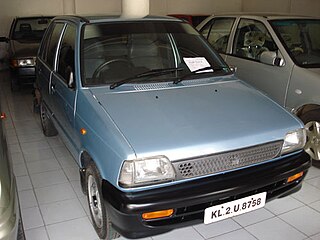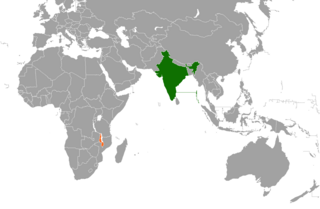Related Research Articles

The gross domestic product (GDP) of Niger was $16.617 billion US dollars in 2023, according to official data from the World Bank. This data is based largely on internal markets, subsistence agriculture, and the export of raw commodities: foodstuffs to neighbors and raw minerals to world markets. Niger, a landlocked West African nation that straddles the Sahel, has consistently been ranked on the bottom of the Human Development Index, at 0.394 as of 2019. It has a very low per capita income, and ranks among the least developed and most heavily indebted countries in the world, despite having large raw commodities and a relatively stable government and society not currently affected by civil war or terrorism. Economic activity centers on subsistence agriculture, animal husbandry, re-export trade, and export of uranium.

The economy of Pakistan is categorized as a developing economy. It ranks as the 24th-largest based on GDP using purchasing power parity (PPP) and the 46th largest in terms of nominal GDP. With a population of 241.5 million people as of 2023, Pakistan's position at per capita income ranks 161st by GDP (nominal) and 138th by GDP (PPP) according to the International Monetary Fund (IMF).

Manmohan Singh is an Indian politician, economist, academician and bureaucrat who served as the Prime Minister of India from 2004 to 2014. He is the fourth longest-serving prime minister after Jawaharlal Nehru, Indira Gandhi and Narendra Modi. A member of the Indian National Congress, Singh was the first Sikh prime minister of India. He was also the first prime minister since Jawaharlal Nehru to be re-elected after completing a full five-year term.

The Maruti Suzuki 800 is a city car that was manufactured by Maruti Suzuki in India from 1983 to 2014. The first generation (SS80) was based on the 1979 Suzuki Alto and had an 800 cc F8B engine, hence the moniker. Widely regarded as the most influential automobile in India, about 2.87 million 800s were produced during its course of which 2.66 million were sold in India itself.

The economy of India is a developing mixed economy with a notable public sector in strategic sectors. It is the world's fifth-largest economy by nominal GDP and the third-largest by purchasing power parity (PPP); on a per capita income basis, India ranked 136th by GDP (nominal) and 125th by GDP (PPP). From independence in 1947 until 1991, successive governments followed the Soviet model and promoted protectionist economic policies, with extensive Sovietization, state intervention, demand-side economics, natural resources, bureaucrat driven enterprises and economic regulation. This is characterised as dirigism, in the form of the Licence Raj. The end of the Cold War and an acute balance of payments crisis in 1991 led to the adoption of a broad economic liberalisation in India and indicative planning. Since the start of the 21st century, annual average GDP growth has been 6% to 7%., India has about 1,900 public sector companies, Indian state has complete control and ownership of railways, highways; majority control and stake in banking, insurance, farming, dairy, fertilizers & chemicals, airports, nuclear, mining, digitization, defense, steel, rare earths, water, electricity, oil and gas industries and power plants, and has substantial control over digitalization, Broadband as national infrastructure, telecommunication, supercomputing, space, port and shipping industries, among other industries, were effectively nationalised in the mid-1950s.

Roughly one-third of Iran's total surface area is suitable for farmland, but because of poor soil and a lack of adequate water distribution in many areas, most of it is not under cultivation. Only 12% of the total land area is under cultivation but less than one-third of the cultivated area is irrigated; the rest is devoted to dryland farming. Some 92 percent of agricultural products depend on water. The western and northwestern portions of the country have the most fertile soils. Iran's food security index stands at around 96 percent.
The energy policy of India is to increase the locally produced energy in India and reduce energy poverty, with more focus on developing alternative sources of energy, particularly nuclear, solar and wind energy. Net energy import dependency was 40.9% in 2021-22. The primary energy consumption in India grew by 13.3% in FY2022-23 and is the third biggest with 6% global share after China and USA. The total primary energy consumption from coal, crude oil, natural gas, nuclear energy, hydroelectricity and renewable power is 809.2 Mtoe in the calendar year 2018. In 2018, India's net imports are nearly 205.3 million tons of crude oil and its products, 26.3 Mtoe of LNG and 141.7 Mtoe coal totaling to 373.3 Mtoe of primary energy which is equal to 46.13% of total primary energy consumption. India is largely dependent on fossil fuel imports to meet its energy demands – by 2030, India's dependence on energy imports is expected to exceed 53% of the country's total energy consumption.

India–Saudi Arabia relations, also referred to as Indian-Saudi relations or Indo-Saudi relations, are the bilateral relations between the Republic of India and the Kingdom of Saudi Arabia. Relations between the two nations are generally strong and close, especially in commercial interests. Indo-Saudi bilateral trade reached US$27.48 billion in the financial year 2017–18, up from US$25.1 billion in the preceding year. Saudi Arabia's exports to India stood at US$22.06 billion whereas India's exports were US$5.41 billion.
The economic liberalisation in India refers to the series of policy changes aimed at opening up the country's economy to the world, with the objective of making it more market-oriented and consumption-driven. The goal was to expand the role of private and foreign investment, which was seen as a means of achieving economic growth and development. Although some attempts at liberalisation were made in 1966 and the early 1980s, a more thorough liberalisation was initiated in 1991.
While beginning in the United States, the Great Recession spread to Asia rapidly and has affected much of the region.

Angola–India relations refers to the international relations that exist between Angola and India.

The Essential Commodities Act (ECA) is an act of the Parliament of India that was established to ensure the delivery of certain commodities or products, the supply of which, if obstructed due to hoarding or black marketing, would affect the normal life of the people. This includes foodstuff, drugs, fuel etc. This act was modified by the Essential Commodities (Amendment) Act, 2020 as part of the 2020 Indian farm reforms.

India–Kenya relations are bilateral diplomatic relations between the Republic of India and the Republic of Kenya.

India–Malawi relations refers to the international relations that exist between India and Malawi.

India–Venezuela relations are the international relations that exist between the Republic of India and the Bolivarian Republic of Venezuela.

Dominican Republic–India relations are the international relations that exist between the Dominican Republic and India. The Dominican Republic maintains an embassy in New Delhi. Since January 2022, India maintains an embassy in Santo Domingo.

Burundi–India relations are the international relations that exist between Burundi and India. Apart from bilateral relations, India also engages with Burundi through the African Union and the Regional Economic Communities (RECs).

Burkina Faso–India relations refers to the international relations that exist between Burkina Faso and India. Burkina Faso maintains an embassy in New Delhi. India maintained an embassy in Ouagadougou from November 1996 until its closure in July 2002. Currently, India maintains an honorary consulate in Ouagadougou, which functions under the jurisdiction of the High Commission of India in Accra, Ghana.

Chad–India relations refers to the bilateral relations between Chad and India. The High Commission of India in Abuja, Nigeria is concurrently accredited to Chad. India also maintains an Honorary Consulate in N'Djamena. In 2019, Chad opened a resident embassy in New Delhi.

India–Mauritania relations are the international relations that exist between the Republic of India and the Islamic Republic of Mauritania. Neither country has a resident ambassador.
References
- ↑ AFP (22 December 2010). "En Inde, le prix de l'oignon peut faire perdre les élections". Libération. Archived from the original on 28 September 2012. Retrieved 3 January 2011.
- 1 2 Magnier, Mark (27 December 2010). "Indians in tears over skyrocketing onion prices". Los Angeles Times. Archived from the original on 24 September 2017. Retrieved 3 January 2011.
- ↑ "The political price of onions". The Hindu (Editorial). 25 December 2010. Archived from the original on 22 October 2012. Retrieved 3 January 2011.
- 1 2 Mishra, Asit Ranjan (21 December 2010). "Skyrocketing onion prices add to government's troubles". LiveMint. Archived from the original on 19 August 2011. Retrieved 3 January 2011.
- ↑ Kazmin, Amy (21 December 2010). "India: politics of onions". Financial Times. Archived from the original on 22 January 2011. Retrieved 9 January 2011.
- ↑ "Indian onions crisis: Custom duty slashed to zero". BBC World. 22 December 2010. Archived from the original on 22 April 2019. Retrieved 3 January 2011.
- 1 2 "Onions, coconuts and the politics of taste in S.Asia". The Dawn. 24 December 2010. Archived from the original on 27 December 2010. Retrieved 3 January 2011.
- ↑ Mehdudia, Sujay (25 December 2010). "Onion starts to cool as tomato soars". The Hindu. Archived from the original on 28 December 2010. Retrieved 3 January 2011.
- ↑ Varma, Subodh (23 December 2010). "The great onion robbery: 135% mark-up from mandi to retail". The Times of India . Archived from the original on 4 November 2012. Retrieved 3 January 2011.
- ↑ "La crise de l'oignon en Inde". L'Humanité. 27 December 2010. Archived from the original on 2 January 2011. Retrieved 3 January 2011.
- ↑ "Onion prices go through the roof, retail at Rs 80/kg in Delhi". The Economic Times. 17 August 2015. Archived from the original on 5 March 2016. Retrieved 27 September 2015.
- ↑ "Onion prices shoot up after India, Bangladesh place import orders". AFP. 2 September 2015. Archived from the original on 28 September 2015. Retrieved 27 September 2015.